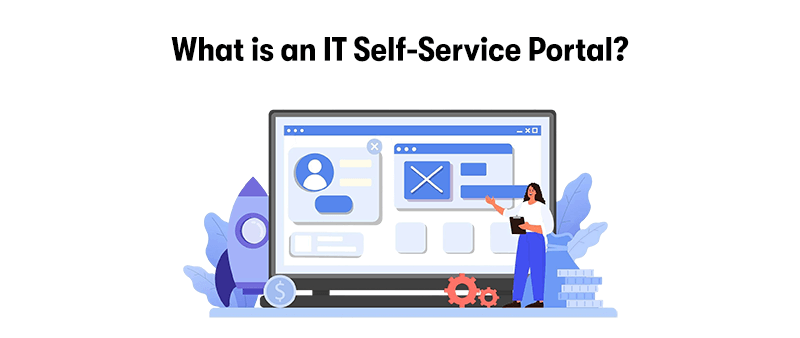IT self-service portals allow users to independently access IT services, resolve issues, and request support through an online platform. These tools streamline IT operations by offering features like knowledge bases, service catalogues, and automated processes.
The idea of IT self-service originated in the late 1990s, as organisations adopted web-based tools to reduce the strain on IT teams. Over the years, these systems have evolved, integrating automation and AI to improve efficiency and user experience.
In this blog, we’ll explain the core functions of IT self-service portals, their importance, and how they simplify IT support for organisations and users.
What is IT Self-Service?
IT self-service refers to a system or platform that empowers users to resolve common IT-related issues and access services without requiring direct intervention from IT support teams. It is typically facilitated through an online portal or knowledge base, providing employees or customers with tools, resources, and automated processes to handle tasks independently.
Key Features of IT Self-Service
Knowledge Base: A repository of articles, guides, FAQs, and troubleshooting steps for addressing recurring problems or queries.
Service Catalogue: A menu of IT services available for users to request or access, such as software installations, password resets, or device management.
Automated Tools: Functions like password recovery, ticket submission, or status tracking, designed to streamline routine interactions.
Chatbots and Virtual Assistants: AI-driven solutions to answer common questions or guide users to appropriate resources in real time.
Benefits of IT Self-Service
Improved Efficiency: Reduces the workload on IT support teams by enabling users to resolve issues on their own.
Faster Resolutions: Common issues, like password resets, are addressed instantly without waiting in a support queue.
Cost Savings: Automating repetitive tasks and reducing dependency on human intervention leads to financial savings.
User Empowerment: By providing the tools and information needed, users gain confidence in managing their own IT concerns.
Examples of IT Self-Service Applications
- Accessing a portal to download approved software.
- Submitting IT tickets with automated tracking updates.
- Searching a knowledge base for troubleshooting tips.
- Using chatbots to get instant answers to simple queries.
What is an IT Self-Service Portal?

An IT self-service portal is an online platform that allows users to independently access IT resources, resolve common issues, and request services without needing direct assistance from IT support teams. It acts as a central hub where employees or customers can find solutions, submit requests, and perform routine IT tasks efficiently.
Components of an IT Self-Service Portal
Knowledge Base: A collection of detailed guides, FAQs, and troubleshooting resources to address frequently encountered IT problems.
Service Request Management: Users can browse a service catalogue to request IT services, such as software installation, hardware upgrades, or access permissions.
Incident Reporting: Simplifies the process of reporting IT issues by allowing users to submit and track support tickets directly through the portal.
Automation Tools: Features like password reset automation or account unlock tools to handle repetitive tasks without manual intervention.
Chat Support: Integrated chatbots or live chat options to provide instant guidance or direct users to relevant resources.
Use Cases for IT Self-Service Portals
- A knowledge base search to find troubleshooting steps for a software issue.
- Raising a request for new hardware or software through the service catalogue.
- Checking the status of an open IT ticket directly from the portal.
- Resetting a forgotten password using automated tools.
An IT self-service portal is an invaluable tool for organisations aiming to boost efficiency, reduce downtime, and empower users to manage their IT needs with minimal dependency on support teams.
What are the Advantages of IT Self-Service Portals?

IT self-service portals provide a wide range of benefits for organisations and users by streamlining processes, improving accessibility, and enhancing the overall IT experience. Below are some of the key advantages:
Increased Efficiency
IT self-service portals allow users to handle routine tasks, such as password resets or software requests, without waiting for IT support. This reduces the workload on IT teams and ensures quicker resolutions for users.
24/7 Availability
Unlike traditional IT support, which may operate on specific schedules, self-service portals are available round the clock. This ensures that users can access services and resolve issues whenever they need to, even outside of regular working hours.
Cost Savings
By automating repetitive processes and enabling users to solve common problems independently, organisations can reduce the time and resources spent on manual support. This contributes to overall cost efficiency.
Improved User Experience
A well-designed self-service portal offers an intuitive interface that simplifies access to IT services and resources. Users can easily navigate the platform to find solutions, request services, or track issues, leading to higher satisfaction.
Faster Issue Resolution
Tasks like resetting passwords or finding solutions to common problems can be completed instantly through the portal. This eliminates delays associated with waiting for IT team responses.
Scalability
Self-service portals can accommodate growing user bases without increasing the burden on IT staff. As organisations expand, the portal can handle more users and requests without compromising efficiency.
Empowerment and Independence
Providing users with the tools and information they need fosters a sense of autonomy. Employees or customers feel more empowered to manage IT-related concerns, boosting confidence and reducing frustration.
Enhanced Reporting and Insights
Self-service portals often include analytics features, allowing organisations to track usage patterns, identify common issues, and improve IT processes based on data-driven insights.
Consistency in Support
Automated workflows and pre-defined resources ensure that users receive consistent and standardised solutions, reducing errors and maintaining quality in IT service delivery.
Focus on Strategic Tasks
By offloading routine support queries to the portal, IT teams can concentrate on complex and strategic initiatives, driving innovation and long-term improvements within the organisation.
What are the Disadvantages of IT Self-Service Portals?

While IT self-service portals provide numerous benefits, they also come with challenges that organisations must consider to ensure successful implementation and adoption. Below are some of the potential disadvantages:
Initial Setup Complexity
Implementing an IT self-service portal requires significant effort to configure, integrate with existing systems, and populate with relevant resources. Poor planning or execution during setup can lead to inefficiencies or user frustration.
Limited Accessibility for Non-Technical Users
Not all users may feel comfortable navigating a self-service portal, particularly if the interface is complex or unintuitive. This can lead to underutilisation of the portal and a continued reliance on IT support.
Inadequate Knowledge Base Content
If the knowledge base lacks sufficient depth or does not cover a wide range of issues, users may struggle to find solutions and revert to contacting IT support, undermining the portal’s purpose.
Dependence on Automation
Automated tools, such as chatbots or password reset functionalities, may fail to address unique or complex problems, leaving users frustrated and requiring escalation to IT support.
Maintenance Requirements
Keeping the portal updated with current information, resources, and features demands ongoing effort. Failure to maintain the portal can result in outdated content and reduced effectiveness.
Lack of Personal Interaction
Some users prefer direct communication with IT staff for reassurance or clarification. The impersonal nature of self-service portals can be a drawback for those seeking personalised support.
Potential Security Risks
Self-service portals, especially those offering features like password resets or access requests, need robust security measures to prevent unauthorised access or data breaches. Weak implementation could expose organisations to security threats.
Overlooked Complex Issues
Portals are generally designed to handle routine and predictable tasks. Complex or unusual problems may not be adequately addressed, requiring manual intervention, which can delay resolutions.
User Resistance to Adoption
Employees or customers may resist using the portal due to lack of awareness, training, or trust in its capabilities. Poor adoption can diminish the portal’s return on investment.
Cost of Implementation and Maintenance
While self-service portals can save money over time, the initial investment in technology, resources, and training can be significant. Ongoing costs for updates and maintenance also need to be considered.
Risk of Misuse or Errors
Users might make mistakes, such as selecting the wrong service or inputting incorrect information, leading to inefficiencies or additional workload for IT teams to rectify the issues.
Mitigating the Disadvantages
To address these challenges, organisations should focus on:
- Comprehensive Planning: Ensuring a well-designed portal that meets user needs.
- User Training: Providing guidance on how to navigate and use the portal effectively.
- Regular Updates: Keeping content relevant and technology secure.
- Feedback Mechanisms: Allowing users to report issues or suggest improvements for continuous optimisation.
Where can you Learn More About IT Service Desk Training?
You can learn more about IT service desk on our SDI® - Service Desk Manager Training Course. This course covers:
- Policy & Strategy
- Leadership & Management
- People Management
- Resources
- Practices, Processes, Procedures
- Management Information & Performance Results
Final Notes on IT Self-Service Portals
T self-service portals represent a transformative approach to IT support, offering a balance of autonomy, efficiency, and scalability. While their advantages include faster resolutions, cost savings, and user empowerment, challenges such as setup complexity, user adoption, and ongoing maintenance require careful planning. Addressing these hurdles ensures organisations can fully harness the potential of self-service solutions. Here are some final tips for success:
- Design a user-friendly interface to encourage adoption.
- Keep the knowledge base detailed and up-to-date.
- Provide training to support non-technical users.
- Regularly monitor feedback and analytics to refine the portal.
By thoughtfully implementing and maintaining self-service platforms, organisations can streamline IT processes and deliver exceptional support experiences.


